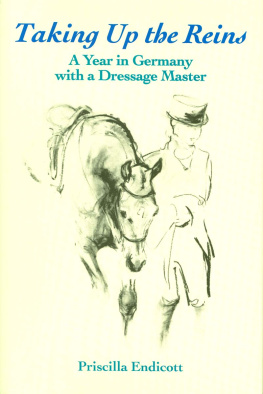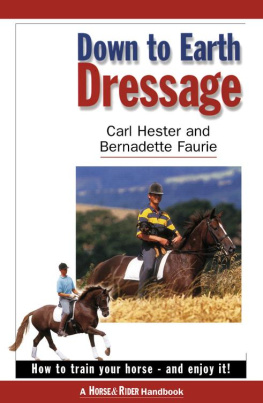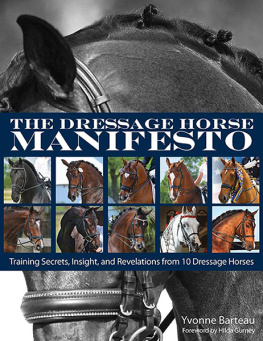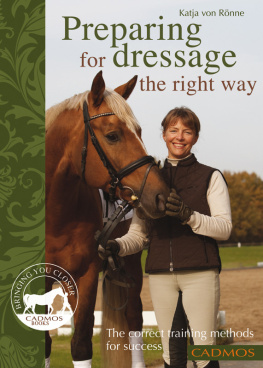

Dedication
For Sheila La Farge who not only convinced me that I had a real story to tell, but who encouraged me to keep on writing until it was done.
First published in 1999 by
Trafalgar Square Books
North Pomfret, Vermont 05053
Copyright 1999 by Priscilla Endicott
All rights reserved. No part of this book may be reproduced, by any means, without written permission of the publisher, except by a reviewer quoting brief excerpts for a review.
The author has made every effort to obtain a release from all persons appearing in the photographs used in this book. In some cases, however, the persons may not have been known and therefore could not be contacted.
Disclaimer of Liability: The author and publisher shall have neither liability nor responsibility to any person or entity with respect to any loss or damage caused or alleged to be caused directly or indirectly by the information contained in this book. While the book is as accurate as the author can make it, there may be errors, omissions, and inaccuracies.
Library of Congress Cataloging-in-Publication Data
Endicott, Priscilla.
Taking up the reins : a year in Germany with a dressage master / Priscilla Endicott; foreword by Denny Emerson.
p. cm.
ISBN 1-57076-134-5 (hc.)
1. Endicott, Priscilla. 2. Dressage ridersUnited StatesBiography. 3. DressageGermany.
I. Title.
SF309.482.E53 A3 1999
798.23092dc21 CIP
[B] 99-44883
Illustrations:
The maps on pages created by 1999 Susan Berry Langsten. Any photograph not credited within its caption is courtesy of the author.
Cover and book design by Barbara Homeyer
Typeface: Goudy
Printed in Canada
10 9 8 7 6 5 4 3 2 1
Table of Contents
Acknowledgments
I always wanted to really ride (as they say in the horse world) for Walter Christensento be for one little instant one of his star pupils, so that he would know how much the wonderful training we did together meant to me. But that high-level dream was unrealistic, given my age, my degree of talent, and general life circumstances.
So I chose another way to honor my Master Teacher and friend. I wrote this book. My aim has been to share my experiences in such a way that they might serve as an inspiration to others, and in this way, spread the wordWalters words along with my wordsand in this manner continue his work beyond his lifetime. I like to think that Walter might look down upon this book from wherever he is, flash that warm half smile of his, and repeat the words I used to treasure when he uttered them, Ist gut, Priscilla, which meant its good, or at least good enough for now. Whenever hed say this, which was once in a while, I knew he was pleased and that would in turn please me enormously.
This book took time in the making. For five years I attended a weekly seminar called Writing for Publication at Radcliffe College Graduate Center. Gail Pool was my instructor the entire time. I could not have been blessed with a more generous, conscientious, and consistently available teacher. I hold a very warm spot in my memory for the other writers in the seminartheir support, encouragement, and criticism was invaluable.
Without my computer friend, Gary Miller, I would have had a hard time. This intuitive man entered my life when the manuscript was in its early stages. He understood immediately that I only wanted to learn enough computerese to allow me to get the book written and he tailored his help to this end.
Thanks to Kerstin Christensen. Without her assistance, I would never have been able to lay my hands on a few of the photographs taken abroad that I desperately wished to obtain.
I give special thanks to Carole MacDonald who so generously donated photographs taken during clinics at The Ark.
I will never forget my final months of getting my manuscript in order. Sybil Taylor came to my rescue, was always infinitely responsive to my needs, saw the subject from my point of view, and was great fun to work witheven through the hard parts.
Finally, I want to thank Caroline Robbins and Martha Cook for their enthusiasm for the book, their attention to detail, their taste, their style, and for the generosity they have both shown in letting me be involved in the fascinating process of being published.
Foreword
The world of American dressage in the late 1960s and the world of American dressage in the late 1990s is not the same world merely separated by a span of three decades. They are two very different universes.
My colleges motto is the Latin phrase, Vox clamantis is deserto meaning a voice crying in the wilderness, that cry presumably seeking knowledge, leadership, and guidance. The phrase aptly describes the state of dressage in this country for many years, despite such bright spots as our USET team bronze medal at the Bromont, Canada Olympics in 1976.
NEDA, the New England Dressage Association, was one of several vigorously active groups attempting to redress the imbalance between Western Europe, where intense discipline and intellectual rigor are traditions of the sport, and the United States, where, in the words of former USET Three-Day Coach, Jack Le Goff, Americans want instant dressage the way they want instant coffee.
Priscilla Endicotts farm, The Ark, in Harvard, Massachusetts, became a mecca and haven for many of us who were vaguely aware that we didnt know very much, and were crying in the wilderness for a valid approach to our various goals.
As an event rider, rather than an upper-level dressage competitor, my own ignorance was proportionally much greater than that of such luminaries as Michael Poulin, Lendon Gray, and Dorothy Morkis, who already had established the fierce work ethic and the ability to embrace minute detail that are needed for success in dressage.
Into this semi-wilderness stepped the towering presence of Walter Christensen, whose gentle demeanor and diffident smile belied enormous drive and intellect. We were drawn to him, many of us, as moths to a flame, but with infinitely more satisfactory outcomes.
All of this is by way of preface to Priscillas logical extension and continuation of her personal quest. Taking Up the Reins, is her deeply personal, sometimes exhilarating, but also often painful account of her year of immersion in the world of German dressage, with all its nationalistic overtones, its structured hierarchy, and its often male dominated culture.
Ive been involved in the three Olympic disciplines enough to know with complete certainty that of the three, Grand Prix dressage demands the greatest degree of precision, exactitude, and total commitment to meticulous detail. These are all traits I think Americans associate with the German mindset, perhaps to the point of stereotype. If Walter Christensens stable was prototypical of national tendencies, those American stereotypes would be accurate. It didnt matter whether the exercise being performed involved perfecting a trot-halt transition or cleaning a stall. Everything had to be done exactly the way Walter wanted it. I saw for myself when I spent a month at Stall Tasdorf in the early winter of 1982.
High above the center of the indoor hall at Tasdorf, suspended by various pulleys and ropes, was a large iron ring. At Christmas, this ring was lowered, liberally festooned with greenery, and re-raised to form a Christmas wreath. The problem was that the ring weighed about 80 or 90 pounds, and was so unwieldy that it was difficult to raise it so that it was symmetrically centered and didnt tilt. Four of use, including Walter, struggled with the cursed thing for thirty minutes or so, directing many un-Christmas-like epithets at it, each other, and the Christmas season in general. No one appreciating its festive appearance would have dreamed how much sweat, effort, and exasperation lay beneath the surface of that particular iceberg. Perhaps, in this little vignette, lies an analogy to the iceberg below perfect one-tempi changes?
Next page














